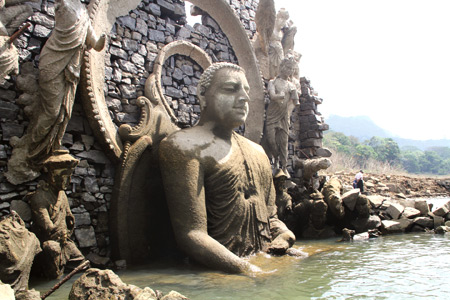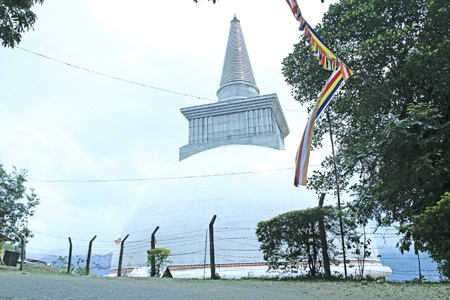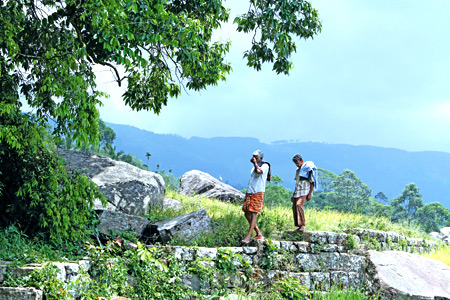|
Mahaweli Maha Seya:
Symbol of social cost of development
By Gamini Warushamana
|

The Kadadora temple submerged by the Kotmale reservoir
Pix by Sudam Gunasinghe
|
Enshrinement of relics in Mahaweli Maha Seya, a Buddhist Stupa in
Kotmale took place recently. This Stupa is significant from the point of
view of development because it can be considered the first Stupa built
to mark the social cost of a development project, the Kotmale reservoir
under the Mahaweli development project.
The construction of mega dams is a controversial topic in
development, globally. There are movements against big dam projects in
India such as Sardar Sarovar of Narmada river, Tehri of the Bhagirathi
river and Tipaimukh of Barak river. Three Gorges dam project in China,
the largest dam in the world also incurred resistance from
environmentalists and the affected people. The project displaced 1.3
million people from their ancestral homelands.
The main concern of development projects of this kind is negative
environmental and social impacts. Threats such as landslides and floods,
environmental destruction such as deforestation, negative impacts on
biodiversity and displacement of people on a large scale are common
issues.
These dam projects are for irrigation, urban water supply or hydro
power generation and Sri Lanka has already exploited most of its
potential in these areas and there are a number of mega dam projects
covering all major rivers in the country.
With these projects we faced similar issues and especially in the
accelerated Mahaweli Development project which created massive
environment and social issues.
Construction work on the Mahaweli Maha Seya was started 30 years ago
following a request of the people who were displaced by the Kotmale
reservoir. The Kotmale dam constructed under the Accelerated Mahaweli
development project caused significant socio-environment issues.
|

The Mahaweli Maha Seya stupa |
Around 7,000 families in over 20 villages in the Kotmale valley were
displaced by this project. The damage to religious and cultural heritage
of the people was massive and 18 Buddhist temples and two Hindu Kovils
were submerged by the reservoir.
The people did not organise protest campaigns against the project or
refuse to leave their homelands though it was a hard decision for them
to leave their fertile lands in the Wet Zone with a mild climate and
move into colonies in Polonnaruwa, Dimbulagala, Maduru Oya and
Dehiattakandiya in the Mahaweli C, H and B Zones in the Dry Zone.
They had to restart their lives from scratch. They had to construct
houses, prepare paddy fields and farmlands to start agriculture. Before
leaving their villages where generations of their ancestors lived they
called upon the then Mahaweli Development Minister, the late Gamini
Dissanayake to build a religious place to commemorate the displaced
people. He agreed to construct this Stupa and the construction work
started in March 1983 but dragged on for over 30 years and came to a
standstill in 1992 due to a variety of reasons. The stage two of the
project was started in 2003 and in 2013 the government decided to speed
up the project and provide funds. As a result today the construction
work of the Stupa has been completed.
The 288-foot high Stupa is just two feet shorter than the Ruwanweli
Maha Seya in Anuradhapura. The structure was designed by the late Dr. A.
N. S. Kulasinghe and the initial estimated cost was Rs.120 million but
has now increased manifold.
The people in Mawela, the only village left here still remember the
sacrifice by their relatives and friends for the betterment of the
country. Mawela village has a long history dating back to the Dutugemunu
era of 161-137 BC.
|

The Mawela village |
According to history, Prince Dutugemunu was self exiled and lived in
this area for over 12 years.
There are many legends stories relating to Prince Dutugemunu's life.
There is a bathing place called Ranamune peella at the top of the paddy
field in this picturesque village and people say that it was built by
the Prince for bathing during his stay here.
Places such as the paddy field where the Prince worked, the
irrigation canal built by him, the meadow where he grazed cattle, all
have legends related to the Prince.
Families with the Lankapeli surname say that one of their ancestors
hosted the prince at their home.
Jayasena Sikurajapathi, a villager said that three decades ago the
villages on the opposite bank of the Kotmale Oya and those submerged in
the reservoir were closely linked and interdependent. There had been a
well-developed iron industry in Kirimanagoda and Nawangama villages
where the people made agricultural tools and arms.
An iron foundry was located in Kottunugoda and the people in these
villages were resettled in Maduruoya, he said. People complain that the
peaceful life in these villages were ruined by the Kotmale project.
According to legend the village has a history going beyond the
Dutugemunu era. This prosperous village was a granary that supplied rice
to the king. All the fertile paddy lands in the village were submerged
by the reservoir. |

